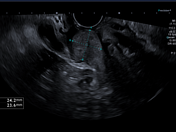Adenocarcinoma of the cervix
Updates to Article Attributes
Adenocarcinoma of the cervix is a histological subtype of carcinoma of the cervix.
Epidemiology
Cervical adenocarcinoma is less common than squamous cell carcinomas (SCC) of the cervix, accounting for ~12.5% of all cervical cancer. Their proportionate prevalence is thought to be increasing and this is thought to be due to being less readily detected by exfoliative cytology obtained with the Papanicolaou test 2-3.
Pathology
As with squamous cell carcinomas, adenocarcinoma type also generally tend to arise from the squamocolumnar junction (SCJ). They may arise from a precursor lesion, cervical adenocarcinoma in situ, and are almost always associated with HPV 18 5.
Risk factors
Aside from smoking, cervical adenocarcinoma has the same risk factors as cervical SCC (see: cervical carcinoma for further details of risk factors) 6.
Classification
There are several subtypes that fall under this category and include:
- clear cell carcinoma of the cervix
- endometrioid carcinoma of the cervix: ~7% of adenocarcinomas
-
mucinous carcinoma of the cervix
- adenoma malignum: ~3% of adenocarcinomas 2
- serous carcinoma of the cervix
- mesonephric carcinoma of the cervix
Adenocarcinomas in general (compared with squamous cell counterparts) are thought to generally give higher rates of thoracic and adrenal metastatic disease 1.
See also
-<p><strong>Adenocarcinoma of the cervix</strong> is a histological subtype of <a href="/articles/carcinoma-of-the-cervix">carcinoma of the cervix</a>. </p><h4>Epidemiology</h4><p>Cervical adenocarcinoma is less common than <a href="/articles/squamous-cell-carcinoma-of-the-cervix">squamous cell carcinomas (SCC) of the cervix</a>, accounting for ~12.5% of all cervical cancer. Their proportionate prevalence is thought to be increasing and this is thought to be due to being less readily detected by exfoliative cytology obtained with the Papanicolaou test <sup>2-3</sup>.</p><h4>Pathology</h4><p>As with squamous cell carcinomas, adenocarcinoma type also generally tend to arise from the <a href="/articles/squamo-columnar-junction-scj">squamocolumnar junction (SCJ)</a>. They may arise from a precursor lesion, <a href="/articles/cervical-adenocarcinoma-in-situ">cervical adenocarcinoma <em>in situ</em></a>, and are almost always associated with HPV 18 <sup>5</sup>. </p><h5>Risk factors</h5><p>Aside from smoking, cervical adenocarcinoma has the same risk factors as cervical SCC (see: <a href="/articles/carcinoma-of-the-cervix">cervical carcinoma</a> for further details of risk factors) <sup>6</sup>.</p><h5>Classification</h5><p>There are several subtypes that fall under this category and include:</p><ul>-<li><a href="/articles/clear-cell-carcinoma-of-the-cervix">clear cell carcinoma of the cervix</a></li>-<li>-<a href="/articles/endometrioid-carcinoma-of-the-cervix">endometrioid carcinoma of the cervix</a>: ~7% of adenocarcinomas </li>-<li>-<a href="/articles/mucinous-carcinoma-of-the-cervix">mucinous carcinoma of the cervix</a><ul><li>-<a href="/articles/adenoma-malignum">adenoma malignum</a>: ~3% of adenocarcinomas <sup>2</sup>-</li></ul>-</li>-<li><a href="/articles/papillary-serous-carcinoma-of-the-cervix">serous carcinoma of the cervix</a></li>-<li><a href="/articles/mesonephric-carcinoma-of-the-cervix">mesonephric carcinoma of the cervix</a></li>- +<p><strong>Adenocarcinoma of the cervix</strong> is a histological subtype of <a href="/articles/carcinoma-of-the-cervix">carcinoma of the cervix</a>. </p><h4>Epidemiology</h4><p>Cervical adenocarcinoma is less common than <a href="/articles/squamous-cell-carcinoma-of-the-cervix">squamous cell carcinomas (SCC) of the cervix</a>, accounting for ~12.5% of all cervical cancer. Their proportionate prevalence is thought to be increasing and this is thought to be due to being less readily detected by exfoliative cytology obtained with the Papanicolaou test <sup>2-3</sup>.</p><h4>Pathology</h4><p>As with squamous cell carcinomas, adenocarcinoma type also generally tend to arise from the <a href="/articles/squamo-columnar-junction-scj">squamocolumnar junction (SCJ)</a>. They may arise from a precursor lesion, <a href="/articles/cervical-adenocarcinoma-in-situ">cervical adenocarcinoma <em>in situ</em></a>, and are almost always associated with HPV 18 <sup>5</sup>. </p><h5>Risk factors</h5><p>Aside from smoking, cervical adenocarcinoma has the same risk factors as cervical SCC (see: <a href="/articles/carcinoma-of-the-cervix">cervical carcinoma</a> for further details of risk factors) <sup>6</sup>.</p><h5>Classification</h5><p>There are several subtypes that fall under this category and include:</p><ul>
- +<li><a href="/articles/clear-cell-carcinoma-of-the-cervix">clear cell carcinoma of the cervix</a></li>
- +<li>
- +<a href="/articles/endometrioid-carcinoma-of-the-cervix">endometrioid carcinoma of the cervix</a>: ~7% of adenocarcinomas </li>
- +<li>
- +<a href="/articles/mucinous-carcinoma-of-the-cervix">mucinous carcinoma of the cervix</a><ul><li>
- +<a href="/articles/adenoma-malignum">adenoma malignum</a>: ~3% of adenocarcinomas <sup>2</sup>
- +</li></ul>
- +</li>
- +<li><a href="/articles/papillary-serous-carcinoma-of-the-cervix">serous carcinoma of the cervix</a></li>
- +<li><a href="/articles/mesonephric-carcinoma-of-the-cervix">mesonephric carcinoma of the cervix</a></li>
Image 4 Ultrasound ( create )








 Unable to process the form. Check for errors and try again.
Unable to process the form. Check for errors and try again.